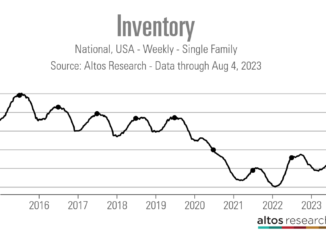
The housing inventory shortage dominated much of the conversation surrounding the housing market in 2022, but thanks to softening homebuyer demand, the number of active listings finished the year up 54.7% compared to the year prior, according to Realtor.com’s December Housing Report.
Despite this sizable yearly increase, active housing inventory was down 33.4% compared to December 2019 and 38.2% compared to the December 2017-2019 average.
“In December, we saw both buyers and sellers pulling back as they continue to adjust to a challenging market,” Danielle Hale, Realtor.com’s chief economist, said in a statement. “Buyers started 2022 facing high home prices and limited inventories and ended the year with interest rates roughly double where they started.”
On average, across the 50 largest U.S. metropolitan areas, the number of homes for sale was up 74.6% compared to a year ago, with the most growth in active listings in the West (+110.2%), which finished the year just 3.9% below its pre-pandemic 2019 level. Among the 50 largest metros, 49 posted yearly active inventory gains in December, with Raleigh, N.C. (+226.2%), Nashville, Tenn., (+226.0%), and Austin, Texas (+186.6%), rounding out the top three. Hartford, Connecticut was the only metro area to record a year-over-year decrease in active housing inventory, dropping 7.7% from December 2021.
Reflecting the seasonality of the market and home sellers’ increased reluctance to list amid weakening buyer demand and a volatile mortgage rate environment, the number of new listings was down 21.0% year over year in December and down 17.7% compared to December 2019. In addition, no region saw a yearly increase in new listings in December, with the West recording the largest annual drop at 32.5%. Of the 50 largest metros, only Nashville (+4.1%) and Buffalo, New York (+3.0%) recorded a yearly increase in the number of newly listed homes.
Despite the drop in buyer demand, the median list price was up 8.4% year over year in December to $400,000. This is the first time in the past year that the annual growth rate was in the single digits. While the pace of home price growth has slowed, home prices continued to rise overall in 2022. According to Realtor.com this signals that fewer buyers are willing to take the plunge amid ongoing housing affordability challenges.
Thanks to elevated mortgage rates and home prices, the typical mortgage payment is up nearly $750 a month, a 58.9% increase compared to a year ago. Realtor.com expects mortgage rates to increase in the early half of 2023 before dropping in the second half of the year.
“Prices are still significantly higher, and homes are selling faster compared to 2019 pre-pandemic levels,” Hale said. “Although demand has softened compared to last year, pushing home price growth into single-digit territory for the first time in 12 months, moderation in home price growth may encourage more buyers to return to the market in the months ahead. Affordability will remain a challenge and buyers will want to keep a close eye on their potential mortgage payment.”
Midwestern metro areas posted the largest annual listing price gains of the 50 largest U.S. metros, with a yearly increase of 12.2%, on average. Milwaukee, Wisconsin (+46.2%), Memphis, Tennessee. (+34.0%), and Miami (+20.4%) reported the biggest annual list price increases of the 50 largest metros.
In addition to slowing asking price growth, the share of active listings with price reductions, also rose in December, jumping up 6.5 percentage points year over year to 13.6%, and up 3.3 percentage points from Dec 2019. Metros in the South (+9.6 percentage points) and the West (+8.7 percentage points) recorded the greatest annual increases in the share of listings with a price reduction. Of the 50 largest metro areas, nine markets reported listing price declines, with New Orleans (-4.4%), Denver (-4.0%), Austin (-3.4%), Phoenix ( -2.4%), and Pittsburgh (-2.3%) reporting the largest decreases.
As homebuyer demand softened, homes spent more time on the market compared to a year ago, rising 11 days year over year to a median number of days of market of 67 days. Despite this increase, homes are selling 16 days faster than they were in December 2019. Of the 50 largest metros, 45 metros recorded an increase in time of market compared to last year, with larger metros in the West seeing the greatest increase (+18 days) followed by the South (+13 days).
In a year over year comparison of time on market, homes in Raleigh, North Carolina (+36 days), Phoenix (+34 days), and Las Vegas (+33 days), posted the largest annual gains in December 2022. Milwaukee and New Orleans recorded the biggest declines, dropping 16 days and 5 days year over year, respectively.



